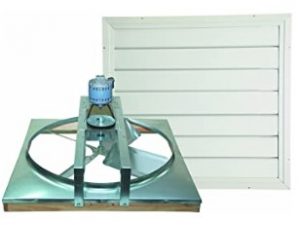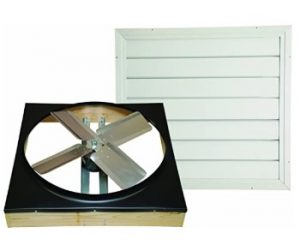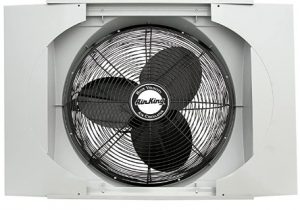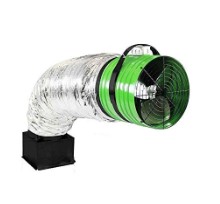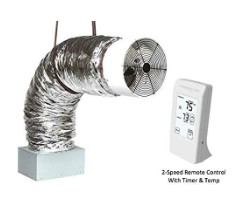Whole house fans are efficient in refreshing your entire home in a short period. This type of fan quickly cools your house during hot summer months, during winter seasons; the whole house fan is best in eliminating stale air thus improving the quality of air to create a healthy environment at your home.
Do Whole House Fans Really Work?
Yes, whole-house fans are effective at cooling houses but under certain conditions. For instance, a whole house works perfectly well when the outside air is cooler than the interior and also when the outdoor air is more humid.
Whole house fans expel the warm and stale air from the interior of the house to the outside through vents like gable, ridge, and passive vents. It then lets in the fresh outdoor air into the house to cool the home. Note that you won’t notice the cooling effect if the outdoor air is warmer than the interior air.
Best Whole House Fans At A Glance:
Followings are the top-rated cooling oscillating fans details and why they are made to our list!
Best Recommended Whole House Fans
How Many CFM Do I Need For the Whole House Fan?
For starters, CFM stands for Cubic Feet per Minute. It’s the rate at which air enters in or out of space. In simple terms, it’s the volume of air that needs to be pushed through a house for it to cool.
To find out the CFM that you need, you should calculate the total volume of air in your house. You can do this by calculating the floor surface of each room. You should then multiply by the height of the respective room and sum the result. This will be the total air volume of your house.
Multiply the result by 30, which is the complete air change that occurs every two minutes. You should then divide the figure by 60 to get the CFM for your house. 75O CFM of airflow requires a square foot of attic air venting. You should choose a fan that fulfills your ventilation demands.
Where Should a Whole House Fan Be Installed?
Many people ask themselves this question when installing whole-house fans. It depends on the home design, but a whole house fan works fine when you put it closer to the center of the house. It would be best if you put it in a clear hallway.
You can identify the best spot to install the fan by selecting the attic joints near the center. Ensure that you provide room for the opening and closing of the fan shutters. Space should not have wires or pipes.
Note that it’s not mandatory to put the fan in the middle of your house. Keep in mind that you will have to open more windows if you put the fan far from the windows. You can also consider placing the fan in the attic because it’s well ventilated.
How Much Does It Cost to Install a Whole House Fan?
It’s difficult to know exactly how much it will cost to install your whole house fan because of the location, quality of the unit, and the roof size. Biding for installation may cost around 600 dollars, depending on the company. Try checking out the cost of various companies before you settle for one. Ensure that you choose a reputable company.
Various factors can affect the final price. For instance, the cost will shoot up if you don’t have the required roof vents. Also, the price may vary according to the region. The materials, the fan, and labor may cost between 1300 dollars and 2000 dollars. However, this price is not fixed.
Is A Whole House Fan Cheaper Than AC?
Yes, a whole house fan is far much cheaper than the AC. Purchasing and installing a whole house fan may cost between $800 and $1800. The cost of buying and installing a central AC ranges from $5000 to $7000 if you have already done the ductwork. The lifespan of a central A/C is 8-15 years, while that of a whole house fan is 16-25 years.
Whole House Fan vs. Central Air Conditioning: When a Fan is a Better Choice
A whole house fan has various advantages over the central A/C. Firstly, a whole-house A/C is energy efficient and has a high cooling power than the A/C. Secondly, maintaining a whole house fan is much easier and cheaper.
There are various things to consider before you choose a whole house fan. Note that a fan works by expelling the warm air in the house and replacing it with the cool fresh outdoor air. Therefore, a fan is a better choice if your outdoor air is cooler than the interior air. Also, you should go for a fan if you don’t have a considerable amount of money to install an A/C.
How Often Should I Run My Whole House Fan?
The best time to run your fan is during the coolest part of the day. The night is usually the coolest part of the night and is the perfect time to run your fan. Running the fan during the daytime may not be productive since the exterior air may be warm.
The optimal time to run your fan varies, depending on how long the day will be at its freshest. You may run it for many hours and still not cool the house because of the warm exterior air. Therefore, it’s ideal for running it only when the outer air is at its coolest.
Do Whole House Fans Use A Lot of Electricity?
Although the amount of electricity depends on how long you run the fan, whole-house fans use far much less power than A/Cs. You will save up to 90% of your bill if you use whole-house fans instead of A/Cs. Therefore, whole-house fans do not use a lot of electricity.
Which is Better, Whole House Fan or Attic Fan?
The answer to this question is not direct. There are times when whole-house fans are the better option, while sometimes the attic fans are the ideal option. You should go for a whole house fan if you are looking for a substitute for your A/C.
The main advantage of a whole house fan is that it cools the entire structure, including the attic, unlike the attic fans that cool the rooms alone. However, attic fans protect your home from mold and prevent attic moisture buildup.
It’s best if you install both fans for maximum cooling effect. The whole house fan will run during the night and the attic fan during the day.
Types of Whole House Fan
There are two main types of whole house fans.
Ceiling mounted whole house fans
As the name suggests, these fans are installed on the ceiling in the space between the living area and attic. They are popular because they are easy and cheap to install. However, these fans produce much noise when compared to ducted fans. Ensure that you choose the location wisely and also check out for energy losses.
Ducted whole-house fans
Ducted whole-house fans are quieter than ceiling-mounted ones and can expel heat from different locations.
Are Whole House Fans Effective?
Yes, whole-house fans are effective at cooling down houses. They replace the warm interior air with cool fresh air from the outside. However, you should note that sometimes these fans are not effective all the time. There working mechanism is not effective when the outside air is warm. Also, they are not effective if you live in polluted areas.
Are Whole House Fans Energy-Efficient?
Whole house fans are energy-efficient since you only run when the air outside is cool. The fresh air will stay in the house for some time before it becomes warm and stale. You don’t have to run it all the time like A/Cs. When compared to A/Cs, whole-house fans can save you up to 90% of your electricity bill.
Whole House Fans vs. Attic Fans
Attic and whole-house fans perform the same duty but using different mechanisms. Attic fans are ideal during the hottest part of the day, while whole-house fans are perfect when the exterior air is cool. When it comes to installation, attic fans are easy to install than whole-house fans. Also, attic fans are less expensive than whole-house fans.
Whole house fans are more energy-efficient that attic fans. Although noise can be a concern for whole-house fans, some new models are quieter.
Whole House Fans Evaluation
You should evaluate your needs before you buy a whole house fan. First, check out your attic for any signs of ventilation. Then look for vents such as gable vents, eave vents, intake vents, and roof louvers. You should then estimate the size of the attic in square feet. For instance, 140 square feet of attic area requires one square foot of vent area. Ensure that you balance the air intake from the exhaust avenues.
Check out for warranties before purchasing the fan. Also, look out for any federal tax credits. Consider buying new fan models since there are quiet, energy-efficient, and well insulated.
Sizing a Whole House Fan
You should consider the size of the fan before purchasing one. The size of a whole house fan depends on the CFM of the air it can move. A bigger house requires large fans for proper ventilation. For instance, a 2000 square feet house requires a 6000 CFM fan. A 1500 square feet home needs a 4500 CFM house. Ensure that there is proper attic venting to expel air out if you are planning on buying a high-speed fan.
When & How to Use a Whole House Fan
The best time to use your whole house fan is when the outside air is cool. Therefore, it’s ideal for running your fan during the night, late afternoons, and early mornings. Running the fan throughout the night is a bad idea since you can oversleep only to wake up when the outside temperature is high.
Ensure that you switch off the A/C before turning on the whole house fan. The main reason why you should do this is that the whole house fan will expel the cool fresh air in the house.
Also, ensure that you open the doors and windows. Failure to open the windows may cause your furnace, water heater, or gas burning appliances to backdraft carbon monoxide and exhaust fumes. Lastly, ensure that you put off the fire at the fireplace.
The 8 Best Whole House Fan Reviews
Cool Attic CX30BD2SPD Belt Drive
This 30-inch whole house fan can cool house with 2000-3000 square feet attics. Apart from making your home comfortable, this fan can help you slash your electricity bills. It comes with a powder-coated finish for resistance from weather elements.
The attic fan works by replacing the stale warm interior air with fresh cool air from the outside. The fan is made in America, and you won’t expect any cheap parts.
The good thing is that it’sits a belt drive fan, meaning it’s quiet. The bracing system prevents vibration, allowing you to sleep and enjoy your time in the house even when the fan is running. The fan is easy to install and comes with a powerful motor that can cycle the air in your house quickly.
QuietCool QC CL-3100 Original Classic Fan Model
QuietCool products have been a game-changer in the fan industry. This QuietCool fan doesn’t disappoint when it comes to ventilating your home. The fan has a self-contained duck system to reduce the vibrations and sound. This fan is known for its noise cancellation features.
The most common problem that affects many fans is energy loss. This fan solves the problem since it comes with a barometric gravity damper system. The slit capacitor motors are efficient, durable, and reliable. The fan has 3120 CFM and cools up to 1500 square feet of attic space.
Cool Attic CX24DDWT Direct Drive
This 24-inch fan is ideal for homes with 1800 square feet of attic space. It comes with quality shutters to prevent the hot air from leaving the unit. Just like other attic fans, it works by pushing the warm interior air to the outside and replacing it with the cool fresh exterior air.
The fan focuses on saving energy while serving its purpose. The parts are of high quality and will last long without repairs. You don’t need to worry about installation since the company has been in the market for a long time.
Nobody wants a noisy fan in their home, and this fan helps solve the problem. The motor is not only strong but quiet and doesn’t vibrate. It’sIt’s easy to install and doesn’t need repairs.
Air Vent Gable Ventilator 53315
This fan is powered by electricity and features a humidistat and thermostat control to prevent moisture and heat from building up in the attic. The good thing is that you don’t have to cut holes in your house since the ventilator can be placed in the gable.
The fan is super quiet and more efficient than other models in the category. The quality shutters close automatically after the fan goes off to prevent heat from spreading in the attic.
The other advantage of the cable is that you can paint it to match your home’s interior. The gable fan comes with a five-year warranty against workmanship defects. Note that fans are expensive devices, and you should have a warranty as security. The four patented rings pull in more air as compared to the steel housing that other gable fans come with.
Tamarack Technologies HV1000 R38 Ductless Whole House Fan
This powerful fan comes with insulated doors that seal themselves when the fan is off. It comes with remote control for convenience. The insulated doors prevent the cool air from entering into the attic. The doors also prevent the warm house air from escaping through the attic.
This energy-saving whole house fan will slash your electricity bill significantly. The fan has two speeds; high speed moves air at 1600 CFM while low speed moves air at 1100 CFM. It can be easily installed vertically or horizontally in the attic. The fan comes with a 6ft power cord for convenience. It comes with a three-year warranty that can be extended.
Note that this is the only whole house fan that has self-sealing doors.
Air King 9166F 20″ Whole House Window Fan
As the name suggests, this fan is placed into the frame of the window. You should ensure that you have a window that matches the height of the fan to prevent it from falling off. The fan has a dial to control the speed of the fan.
Although window fans are known to make noise, the Air-King doesn’t make a lot of noise. The fan makes 64 decibels of noise when at high speed and 50 decibels of noise when you are using low speed.
The fan is made from sturdy plastic that resistant to impacts. It won’t break easily even if it falls from the window. It will continue to work properly, even if it falls.
The blades are powder-coated steel that can withstand extreme weather. The blades are solid and durable. The Air-King whole house fan is fast, efficient, and affordable. You can buy it without breaking the bank.
Quietcool QC ES 6000 CFM Advanced Whole House Fan Cooling System
This energy-saving whole house fan can improve the ventilation in your house while reducing the electricity bill. The fan moves 3500 CFM of air when on low speed and 5580 CFM when on high speed.
The fan can cool a house of up to 2790 square feet effectively. The installation of this fan is easy and takes around 2 hours. It doesn’t require joist-cutting or framing. It features an R5 damper box for insulating the home from the attic when the weather is cold, and the fan is off. The motor uses 112 watts when on low speed and 455 watts when on high speed.
QA-Deluxe 3300(R2T) Whole House Fan
The QA-Deluxe fan offers you a great way of cutting your electricity bills by over 70 %. The fan can cool homes with attic space of up to 1550 square feet. It comes with remote control, digital timer, and a wall switch for controlling the speed. The fans use a cloth-line ducting and have a suspended motor to reduce noise.
The unit is easy to install and takes only 90 minutes. The fan comes with a ten-year warranty, which is more than other brands.
Things to Consider When Buying the Best Whole House Fan
There are many fan brands in the market today, and choosing the best fan can be a problem. However, there are certain features that you should look out for in a whole house fan.
1. Noise
Since the fan will mostly run even at night, it’s important that you go for a quiet fan. You don’t want to buy a fan that will not let you sleep in peace. It’s easy to differentiate a quiet fan from a noisy one. Quite fans have more blades than noisy ones. Also, ensure that the fan has a welded frame to prevent it from loosening.
Also, ducted fans are quieter than ceiling mounted ones. Belt-driven produce less noise than direct models. Putting your fan on the high-speed mode will make it produce more noise.
2. Timer control
Remember that you need to put on the fan when the door and windows are open. It’s ideal that you have a timer than a thermostat since the latter can put on the fan when no one is at home.
3. Shutters
Poor shutters may produce unpleasant thumping noises when the unit goes off. Therefore, its important that you choose high-quality shutters. Some efficient fans come with insulated shutters that seal themselves when the unit goes off. They prevent the heat from spreading to the cool room when the fan is off.
4. Convenience features
Ordinary fans come with pull chain operation that’s not convenient. Therefore, it’s best if you spend extra dollars on a wall switch. Also, buy a fan that has a remote control.
5. Size
Look for a bigger fan that performs well at lower speeds to save energy. Heavy fans are quieter than light ones since they rest on foam weather-stripping.
6. Installation
Whole house fans are not hard to install. A direct-drive fan is easier to install, and you can do it by yourself since there are no attic joists to cut. Belt-drive fans have a complex pulley system that makes it hard to install.
Conclusion









